The Sketches and the Work
by Martina Homma
Translated by Michał Kubicki
For anyone who ventures into research in the arts, it is always fascinating to follow the individual creative process, this highly engaging path from the first misty ideas through numerous steps (only some of which are taken without hesitation ) to the final artistic product as it gradually takes shape. In music, it is thanks to composers’ sketches that the creative process can be analysed by an outside observer. The finished work, these paths allow us to forget about the preceding artistic explorations.
Without the sketches, the inner secrets of the composer’s endeavors would remain a mystery. The sketches make visible the unpredictable paths of creative thinking and make it possible to comprehend what usually remains unperceived. The foundations upon which his creative process rests shed much new light on the artist and his work. The selection of Witold Lutosławski’s sketches for Trois poèmes which were featured in the exhibition held on the occasion of the Polish Radio’s “Witold Lutosławski Concert Studio” (on 27 September 1996) was not a step-by-step documentation of the respective stages of his work on each fragment of the piece. Instead, the central idea was to present, from different points of view, as many aspects of Lutosławski’s compositional thinking as possible.[1]
I.
“… I never start composing before I have a specific idea of the form of the given work. In my eyes a composer always has to begin his work from two perspectives: from above and from below. What I really want to say is that in order to get to know all the details about a town it is not enough to walk along its streets-it is also necessary to get a bird’s eye view of the place. As far as I am concerned, before I set about composing I first have to gather sufficient material from both points of view. On the one hand it is clear idea of the form, on the other the key musical ideas.[2]
In the case of the vocal-instrumental compositions, the overall concept of form is linked to the subdivisions of the text.[3]
All Lutosławski’s pieces of this type, from the earliest vocal works (i.e. the simple songs for children) to the late composition with text, contain, in his typed manuscript of the text, directions as to the key words and the subdivisions of the work.
The most general of the sketches for the Trois poèmes is a sheet of paper with a text lacking any subdivisions concerning the work’s movements, yet, it already indicates its culminating point. Lutosławski’s concept of form evidently leans towards one (and only one) climax. During the initial stages of composition, before focusing on a specific part of the piece, on the form or the sequence of pitches and rhythms, Lutosławski jots down (habitually on pages taken out of a math exercise book) “the key ideas” relating to the sound shapes at specific points of the composition, along with general remarks concerning the compositional techniques to be used. In Trois poèmes Lutosławski was preoccupied primarily with the “organization of time,” that is the problem of “aleatory counterpoint” and the use of two conductors, one for the choir, the other for the orchestra. One of his sketches, not reproduced here, illustrates these types of deliberation, using the example of the third movement, “Repos dans le malheur.”
In the early stage of “limited aleatoricism” (Trois poèmes is Lutosławski’s second composition written in his technique, which he describes in his commentary on the work), Lutosławski took as his starting point the assumption that form consist of “objects.” In Trois poèmes, these objects are the musically -interpreted fragments of text, in which the individual vocal line is treated as the “raw material” (matiere premiere). In a conversation, he once drew attention to one aspect of textual declamation: “In my work on the score, I am trying to figure out how particular phrases would sound in everyday use. Sometimes I shouted them out and them wrote them down (…)”[4]
The concurrent layering of different variants of the same line (many figures, almost the same but never identical, sounding simultaneously) creates in its “aleatory counterpoint” a rhythmically differentiated sound field. The sketch reproduced below as no. 6 illustrates how the line of expression in such sound fields is shaped.
Sketch no. 1 demonstrates the diversity of the “key ideas:” from terse notations of general sound concepts to general studies (see Figure 1).
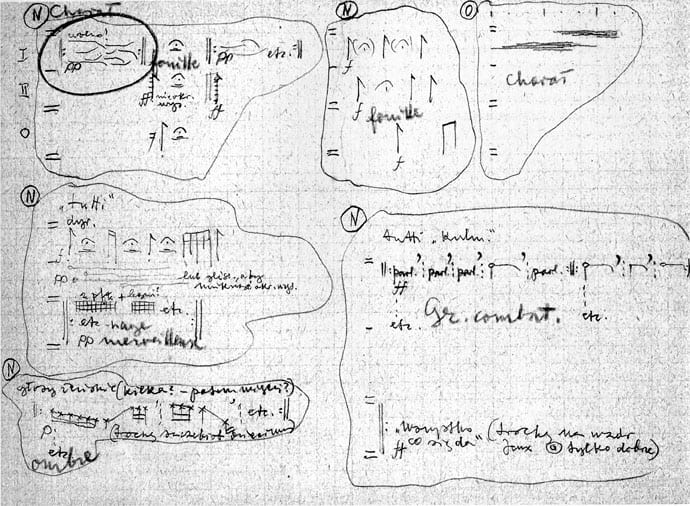
Witold Lutosławski Collection. Paul Sacher Foundation, Basel.
This sketch contains (on the basis of the central words: “fouille,” “nage,” “marveilleuse,” “ombre”) six examples of how the “key ideas” are notated for the various episodes of the piece. At this early stage of work on a new composition we see in the first rank either remarks concerning dynamics, or rhythm, instrumentation, articulation and the shaping of the sound space. Typically for such an early stage, these remarks are general directions concerning the imagined sound world. Three of those “key ideas” (even though they were not realized literally in the final version of the piece) refer to the climax of the work. Lutosławski’s remark in the right-hand corner of Sketch no. 1 is highly meaningful: “Wszystko co się da (trochę na wzór Jeux tylko dobrze)” [Everything that can be achieved (slightly modelled on Jeux but well done)]. In his sketches, Lutosławski often referred to his earlier compositions, in this case to Jeux venitiens (1961), which directly preceded Trois poèmes. Sometimes we also encounter references to pieces written decades earlier: In his sketches to the Double Concerto, Lutosławski returns to Twenty Carols dating from 40 years earlier, while in his work on the Third Symphony, completed in 1983, he harked back to his incidental music of the 1950s.
“As in Jeux but well executed…” Often, having completed a piece, Lutosławski spoke about his sense of inadequacy.[5]
Indeed, such feelings accompanied him whenever he tackled a new project. His desire to have his musical ideas realized more fully and more precisely than in the previous piece is given ample proof in the following remarks in the sketches: “similar to the place in the work but better.” The climax of Trois poèmes, in the way it focuses its structure on the word “fouille,” is alongside the above-mentioned remark concerning Jeux venitiens (Sketch 1), among the episodes which lend themselves most readily for use as points of reference. The two “key ideas” jotted down at the top and in the middle of the left-hand side of Sketch 1 refer to this climax. Another sketch, not reproduced here contains studies on the handling of the vocal parts (in its upper section). One can observe here a sort of “pedal note effect,” achieved through the gradual introduction of new notes. This kind of approach was subsequently to play a significant role in Lutosławski’s harmonic and melodic pitch organization. The dualism of horizontal and vertical/diagonal structures, as well as the problem of the harmonic impact created by newly-introduced melodic lines, was discussed by the composer in the 1970s (on the example of Preludes and Fugue).[6]
This concern is openly expressed in the remark on the upper right-hand side of Sketch no. 1: “gra kontrastów linii i pionów, np. w linii 1,1,etc., w pionie 2,5, etc.” (the play of contrasts between the vertical and the horizontal, e.g. horizontally 1,1 [M.H.: i.e. minor seconds] etc, vertically 2,5 [M.H.: i.e. whole tones and perfect fourths], etc.).
II: First Movement, “Pensées”
While sketches with the most general ideas (as Sketch no. 1) illustrate the early stages of the compositional process, the subsequent groups of sketches demonstrate, with regards to the first movement of this work, the various stages at arriving at a fair copy, leading directly to the stage immediately preceding the final version. Some of these sketches, e.g. Sketch no. 2 (see Figure 2).

Witold Lutosławski Collection. Paul Sacher Foundation, Basel.
The beginning of Trois poèmes (Fig. 2) constitutes at the same time a pivotal moment in the development of Lutosławski’s compositional technique: he superimposes polymetric entries of individual instruments (c.f. the remark “chorał instrumentalny” (instrumental chorale) in the lower right-hand corner of one of the sketches not reproduced here) by introducing a systematic patterning of pitch and duration, which will be developed in later compositions within his “aleatory counterpoint.” Sketch no. 2 elaborates the ways in which Lutosławski reaches this combination of pitch and rhythm. Another sketch from the same stage in the work’s genesis, reproduced here as Sketch no. 3 (see Figure 3) contains six twelve-note chords (from alpha to lambda) which contract from a symmetrical chord (made up of whole tones and perfect fourths) to a full semitonal cluster (spanning a major seventh). In turn, the rhythmical sequence observed in Sketch no. 2, in which pairs of instruments are given the same rhythmic pattern, also shows that each instrument is given an individual sequence of number which indicate the pitch of each note taken from the full twelve-note harmony. This is a rare example in Lutosławski’s sketches in that it is marked in color. Along the bottom of Sketch no. 2 Lutosławski has indicated, in a kind of a “short score,” the succession of different pitches, the idea being to test the succession of attacks and the intervals which emerge. There exist several similar sketches of the opening section of Trois poèmes.
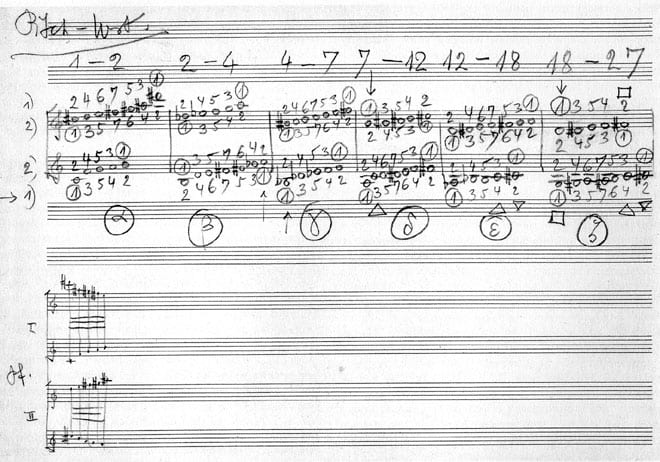
Witold Lutosławski Collection. Paul Sacher Foundation, Basel.
Sketch no. 2 comes the closest to the final, published version of the score, corresponding to its first page and the first four twelve-note chords employed in the work (marked in Sketch no. 3 as alpha to delta). The change from one twelve-note chord to another takes place over longer and longer periods of time: the first chord takes approximately 1-2 seconds, while the last takes about 8 seconds.
The “numerical” organization of registrally conceived fragments (c.f. the upper left-hand side of Sketch no. 4) is illustrated in two, mutually intertwined sketches referring to fig. 91 in the score. The succession of notes, starting with an unison and expanding downwards, was shaped according to a principle which could be represented by numbers, illustrated in another sketch where the parts of the three flutes and the first oboe appear in the upper four rows of numbers; below them, separated by the a horizontal line, the second oboe part and the three clarinets are represented.
Creating such numerical sequences has never been for Lutosławski an end in itself. The aim of adopting organizational techniques of this kind is a wish to eliminate identical lines, given the extensive similarities between them, as well as to subordinate pitch patterns and rhythmic values to a common principle. Lutosławski has developed many similar arithmetic and visual variants, particularly for his “aleatory counterpoint.”[7]
Textures shaped in such a way retain far-reaching flexibility, changeability and multifarious character; radical examples are to be found in the earlier Jeux venitiens. In contrast to that composition, however, Trois poèmes concentrates on homogeneous, textures, i.e. with just one or two rhythmic values, a highly limited stock of melodic cells (even though kept within the twelve-tone harmony) and a consistent principle of numerical construction, functioning here as the “generators of change.”
III: First Movement, Pensées
Sketch no. 4 brings out in very condensed form several aspects which are of vital importance for an understanding of Lutosławski’s compositional concepts (it illustrates most vividly the significance of the movement of sound in space; fig. 91-142 in the score). This sketch (see Figure 4) is an example of an advanced stage in the composition, in which the basic elements of form, relating to pitch organization and the selection and movement of sounds in space, are almost ready. The sketch contains a time axis running from left to right, indicating the specific proportions for durations (c.f. the numbers at the bottom of the sketch). The upper fragment of the sketch contains directions relating to the instrumental forces: woodwind and the piano, initially alternating and then together,and finally (on the right-hand side of the sketch), the harp and pitched percussion. Reading down the sketch it is possible to see a range of geometrical figures which indicate the changing sounds and textures: a bound of sound, now broad, now narrow, rising and falling, contracting and expanding.
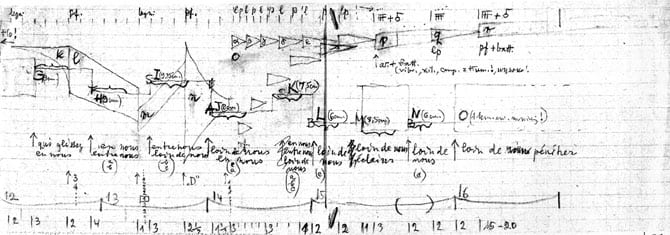
Witold Lutosławski Collection. Paul Sacher Foundation, Basel.
This whole fragment starts and ends with a unison in the highest register. Each of these geometrical figures refers to one or more cells within the twelve-note structure: the broad band of the left-hand side of the sketch (fig. 91-103 in the score) is an example of three twelve-note chords with a widening ambitus, while the falling sound band (“1”) leads to six twelve-note chords, etc…[8]
The sound complexes marked by letters (small for the orchestra, capital for the choir) are accompanied by markings (given in centimeters) relating to the space assigned to them in the finished score-these correspond to the planned space -time notation. In the middle section of the sketch, black arrows are aligned with the words of the text, and beneath them are columns of numbers (3,4…;222122…;”D”, 111…) which relate to the interval structure of the corresponding twelve-tone harmonies.
The sequence of musical events in this important fragment brings to light the details of harmony, instrumental forces, sound space and textual interpretation. These details have not only a local but also a broader significance which reaches beyond Trois poèmes itself. The gist of Lutosławski’s concept, which can be detected in the sketches, is the defining of principles relating to the organization of sound and space, of duration and rhythm and of intervallic and harmonic patterns. In all his compositions, this concept leads to the highest possible diversity of details and their integration into an aurally perceptible musical argument. Lutosławski eventually abandons conjoined spatial figures in his search for diversity of detail, preferring instead a sequence of wedge shapes (whose ambitus gradually expand) and rising melodic lines which move higher and higher in register, etc…The gradual transformation of the twelve-tone interval structure, the increasingly refined succession of changing timbres and the development of registral space also have the characteristics of a process.
Sketch no. 5 makes it possible to focus even more closely on similar spatial shaping, this time of larger fragments from the piece. This sketch (see Figure 5) shows an excerpt from the first movement (fig. 34-84 tn the score), where characteristic groups of woodwind pulses occur as a succession of sound-spatial figures, on the two-stave marked “I (“I” stands for instruments). In the top system (marked “C” for choir) this sketch contains a summary of the choral parts, which are heard simultaneously with the instruments. (This is where the choir sings the words “Ombres” (de mondes intimes), “ombres” (d’ombres), “cendres” (d’ailes) up to the twelve-note chord where, on the right-hand side of the central section of the sketch, Lutosławski writes the words “pensées à la n[age] m[erveilleuse]”). The white notes here are the more important for the perception.
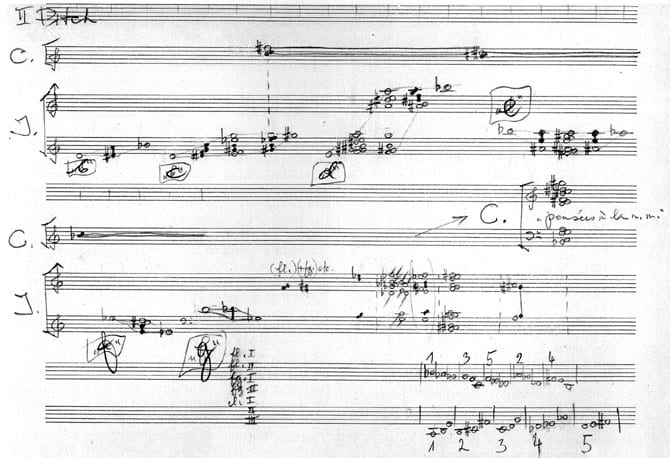
Witold Lutosławski Collection. Paul Sacher Foundation, Basel.
Another sketch for the same segment (not reproduced here) is only one remove from the final fair copy of the score and contains a succession of pulses for individual instruments written in space-time notation; these pulses create canons of note-groups and instrumental entries.
The structural principle of the entire section consist of two symmetrical (palindromic) changes of density in the development of pulses. The basic pattern of this principle is clearly readable at the beginning of the parts for the first flute and the first clarinet. The remaining instruments start successively, each on a different note of this cyclical rhythmic series.
IV: Second Movement, “Le grand combat”
The culmination of the second movement of Trois poèmes is one of the most compact and complex episodes to come from Lutosławski’s pen. One of the manuscripts corresponds almost fully to the fair copy, with the vertical lines standing for the score’s division into pages. Even a cursory glance at the texture reveals a subdivision into three sound layers: (a) piccolos, flute and first clarinet, (b) oboes, clarinets 2 and 3, trumpets and trombones (c) bassoons, horns and pianos. Each of these layers has its own symmetrical twelve-note chord, notated in the upper left-hand corner of another interesting sketch where semitones and major second are used for layer (a), minor thirds and (almost exclusively) major seconds appear in layer (b) and perfect fourths, semitones and major thirds are utilized in layer (c). The rhythmic shaping of the harmony of the three superimposed twelve-note chords makes it possible to decipher Lutosławski’s methods of permutation, about which the sketches say very little. These very consistently introduced patterns contain for each version of the motif both the specific number of semi-quavers, the number of different pitches. The registral spectrum contracts at its progresses towards the conclusion of this vast climactic texture. Within the harmonic twelve-tone-spectrum each orchestral part has its own horizontal profile. This can be seen in subsequent sketches where Lutosławski has indicated pairs of intervals for specific instruments: seconds for the piccolos and flute, thirds for the oboes and clarinets, perfect fourths and tritones for the bassoons and horns. Such interval studies, leading, as here, to a realization in the final score, are accompanied by numerous studies of the more general character. Over decades Lutosławski has been guided in such studies by the desire to create a specific sound world. This was demonstrated, among other things, by the dominance of one or two types of interval. In Lutosławski’s case, this design is connected with his “twelve-note technique”, conceived as “the exclusive, permanent and equal use of twelve notes forming a whole” according to the definition of twelve-tone-music in Handbuch musikalischer Terminologie.[9]
In Trois poèmes, as basically in all Lutosławski’s compositions from the 1960s, the character of his twelve-note technique is first and foremost vertical, dominated as it is by fixed twelve-note structures, where each note of the three chords not only has its place within the sequence but also has an octave register assigned to it.[10]
Such sketches illustrate in an exceptionally clear way the strong subordination of horizontal intervals to the vertical design, so characteristic of the 1960s. (In the ensuing decade, this hierarchy was to undergo a change in favour of a more horizontal approach).
Sketches included in the following group of material refer to sections which occur on either side of the climax. The textual and musical climax concerns the defeat of one of the fighters and his futile attempts to rise to his feet again. In Sketch no. 6 (see Figure 6) the “key ideas” have been integrated into a sequence of events prior to the climax and its move into the highest register. In the upper part of the sketch the Greek letters relate to expanding twelve-note chords on the brass. The wavy lines define the sound space of rising percussion. The composer’s remark “8 wspólnych” (eight common) denotes that eight notes of the twelve-note chord are common, in octave positions, to all instruments in different octave positions.[11]
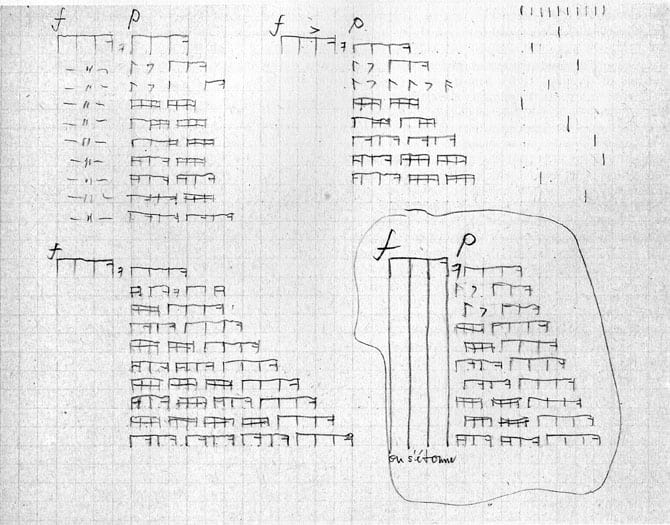
Witold Lutosławski Collection. Paul Sacher Foundation, Basel.
The lower half of the sketch refers to the percussion instruments where they rise to the highest registers. Above them are outlined the vocal parts.
It is worth noting that it is rather rare for Lutosławski to cross things out at this stage of the composing process (see the bottom right-hand corner of Sketch no. 6). What ensues after the registral contraction seen in Sketch no. 6 is the true explosion of sound in the climax. The death of the defeated leads, after a tension- filled moment of sudden silence, to a symbolic and indiscriminate desecration of the dead body in an effort to find the “grand mystery” in the dead man’s bowels.
One of the sketches for this section of the work contains a draft of the declamation of the relevant textual fragments with an alternative variant for the ending of this movement. The astonishment of the crowd is rendered by the utterances of the choir, whose individual voices, initially in rhythmic unison, gradually become independent of one another. The bottom of Sketch no. 7 (see Figure 7) contains a sequence which is built on the following idea: regularly expanding rhythmic values are inserted between identical, or almost identical cells. This is an idea employed by Lutosławski in many of his later compositions.
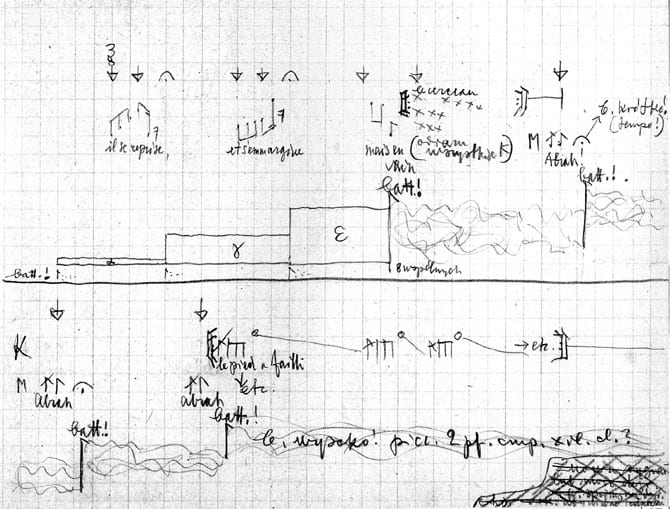
Witold Lutosławski Collection. Paul Sacher Foundation, Basel.
Considering that in the score this episode is written in space- time notation, it may come as a surprise that in the sketch it is conceived in traditional rhythmic values. Such “traditional” notation was also in fact possible for some of the other choral and orchestral textures in which traditionally notated rhythmic values were abandoned: the distances between noteheads do not correspond anywhere to “haphazard” irrational durations, but are arranged proportionally, so that it would be also possible to notate them traditionally. Lutosławski takes up this issue in remarks preceding the publication of the score.
It is likely that in connection with the publication of Trois poèmes, and his subsequent experience stemming from the work’s performances, later compositions (with the exception of Livre pour orchestre) abandon the new notation which Lutosławski had tried out in Trois poèmes.
V: Third Movement, “Repos dans le malheur”
Sketches for the third movement may be chosen to best illustrate textural studies for the choir. They include one sketch with a hand-written remark at the bottom that special attention: “obmyśleć sposób, żeby nie unis.” (devise a way to avoid unison), i.e. given the in-built similarities between the vocal lines, actual simultaneities must be excluded. In addition to the disposition of fermatas on different notes in each part (the disposition being identical within each group of voices, we have in each voice a different division of the second to obviate any unisons: 1, 2/3, 1/2, etc., as is notated in one of the sketches. Here, curved arrows over single notes further adjust the distance between the noteheads in the initial entry of the choir (see fig. 4 in the score).
This choral entry is preceded by an instrumental introduction for harp and two pianos, whose draft is contained in Sketch no. 8 (see Figure 8). On the upper systems Lutosławski jotted down ideas relating to twelve-note chords, one of which he has ringed for use in the introduction. On the right-hand side we can see two revealing examples of melody within a chord through a succession of notes “fixed” in their octave position. The piano sequence, notated after the double barline (before fig. 3 in the score), begins with a succession of perfect fourths and ends with a chromatic sequence. The twelve-note successions (in the middle of the third system of the sketch) correspond to intermediate steps between the initial line of perfect fourths and the semitonal sequence at the end. The piano part will refer to these structures once again (fig. 12 in the score). The horizontal profile of this progression is subjected to specific fluctuations in the a-metrical textures of the piano material, but what can still be heard is the consistent evolution of one interval structure to the next.
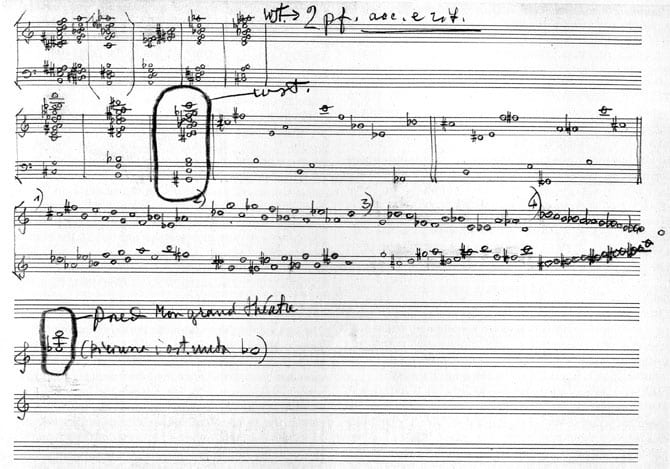
Witold Lutosławski Collection. Paul Sacher Foundation, Basel.
Similar twelve-tone successions built from just one or two intervals are to be found in many of Lutosławski’s works (especially in the 1960s), introduced as they were to transform chords into melodies. Trois poèmes, particularly in the first movement, is the work which contains the most complex examples of the mutual intertwining of chords and twelve-note progressions.[12]
The cluster outlined at the bottom of Sketch no. 8 is also made into a melody in the final version of the piece by such a twelve-note transformation. In the score, it precedes the entry of the choir, starting with E-flat.
Lutosławski’s short draft of a possible letter to his publisher, PWM in Kraków, highlights the importance that the composer attached to adhering, in the published score, to the spaces between the notes which he had indicated in his manuscript. Even without knowing the work and the requirements it places on the performers (if only to mention coordinating the activities of the two conductors), these sketches go a long way to show how important accurate space-time notation is for the rhythmic organization.
Notes
[1]. An attempt has been made to follow the successive stages of work on Lutosławski’s Cello Concerto in Martina Homma, “Zwölftonharmonik and Prakomposition des Materials. Uberlegungen zu Konkretisierungsgraden in Witold Lutosławski Cellokonzert;” in Quellenstudien II, Zwolf Komponisten des 20. Jahrhunderts, Veroffentlichungen der Paul Sacher Stiftung Vol. 3, ed. Felix Meyer (Winterthur 1993), 205-232. The earliest publication on Lutosławski’s sketches for the Jeux venitiens was by Adrian Thomas, “Lutosławski at the Crossroads,” Contact 24 (spring 1982): 4-7. [Back]
[2]. Quoted in Couchoud, Jean Paul: La musique polonaise et Witold Lutosławski (Paris, 1981), 89. See Martina Homma, “Vogelperspektive und Schlusselideen. Uber einige Aspekte der Kompositionstechnik Lutosławskis anhand kompositorischer Skizzen.” Musik- Konzepte Bd. 71/72/73 (1991): 33-51. [Back]
[3]. In connection with Paroles tissées, the composer himself explained how, on the basis of the text alone, he immediately “saw” his four- part piece. C. f. “Konserwatorium na temat utworów wokalno- instrumentalnych Witolda Lutosławskiego,” Stefan Jarociński, in: Spotkania muzyczne w Baranowie 1976, (Seminar on Witold Lutosławski’s vocal- instrumental works, led by Stefan Jarociński, Musical Meetings in Baranów, Kraków: PWM, 1978), 98-100; Tadeusz Kaczyński, Rozmowy z Witoldem Lutosławskim (Conversations with Witold Lutosławski), Wrocław, 1993, p.43. [Back]
[4]. Kaczyński, Tadeusz, Gesprache mit Witold Lutosławski; with a supplement by Balint Andras Varga, Neun Stunden bei Lutosławski, Leipzig 1976; Lutosławski im Gesprach mit Varga, p.202. [Back]
[5]. Lutosławski expressed such sentiments on several occasion including a conversation with Krystyna Bielawska, “Akt twórczy to akt rezygnacji,” [A creative act is an act of resignation] Literatura 2 (March 15, 1993): 13.[Back]
[6]. Couchoud, op.cit, pp. 136- 149 and Kaczyński, Gesprache, p.75 [Back]
[7]. For a discussion of the principles of the organization of “aleatory counterpoint” see Martina Homma, Witold Lutosławski. Zwölfton- Harmonik, Formbildung, “aleatorischer Kontrapunkt”. Studien zum Gesamtwerk unter Einbeziehung der Skizzne (Cologne: Bela Verlag, 1996), 235- 373. [Back]
[8]. In reference to the harmonic language of the piece, see also Martina Homma, “O przestrzeni muzycznej w harmonice dwunastotonowej Witolda Lutosławskiego” [About the musical space in Witold Lutosławski’s twelve- tone harmony]. Muzyka no. 1-2 (1995): 94-98. [Back]
[9]. From the definition of “Zwolftonmusik,” entry by Michael Beiche, in Handbuch musikalischer Terminologie, Ed H. H. Eggebrecht (Stuttgart 1972). [Back]
[10]. see Homma, Lutosławski, 390-412. [Back]
[11]. Lutosławski analyzed about methods of pitch organization in a paper “O rytmice i organizacji wysokości dźwięków w technice komponowania z zastosowaniem ograniczonego działania przypadku,” in Spotkania muzyczne w Baranowie: Muzyka w kontekście kultury, (Kraków: PWM, 1978), 76-87; (reprinted as “Rhythm and the Organization of Pitch in Composing Techniques Employing a Limited Element of Chance,” in Polish Musicological Studies, vol. 2 (Kraków: PWM, 1986):. 37-53. [Back]
[12]. For examples from Trois poèmes, see Hommma’s article in Muzyka. [Back]
General Editor and Owner, Bela Verlag Music Publisher, Cologne, Germany. Specialist in Polish music after World War II, sketch studies and gender issues; Chair of ISCM Cologne section and of Frau Musica (nova). Dr. Homma received her doctorate in 1995 for the Witold Lutosławski monograph from the University of Cologne. The author of over 40 scholarly articles, including studies of Lutosławski, Panufnik, Górecki, as well as Bach and Schumann, dictionary entries on contemporary Polish composers, reviews and essays. Homma served as author and editor of books about Paweł Szymański (forthcoming) and Krzysztof Meyer (with M. Jabłoński). Her most recent publication is an edited volume of studies of women composers, Frau Musica (nova), (Sinzig: Studio Verlag, 2000). Her scholarly interests range from 19th and 20th century music, through gender studies and women composers, sketch studies, and reception history.
Dr. Homma completed studies in piano, music theory, pedagogy (Cologne Music Academy), and in philosophy, German studies, musicology, Slavonic studies (Cologne University). She is a recipient of grants from the German Academic Exchange Council for two years of post-graduate-studies in Poland (Cracow, Warsaw). As a lecturer she has been teaching at the Cologne Music Academy (counterpoint, score reading), and as the visiting professor at the University of Siegen 1998/1999. Her list of publications may be found at: www.homma.de. For her work as publisher visit www.bela-verlag.de.